The composite mast for the second Type 26 Frigate, HMS Cardiff, has been installed.
The mast from specialist supplier Umoe Mandal in Norway arrived last year.
The mast structures are constructed from military-grade composite materials.
For modules that are installed high up on the vessel structure, using lightweight composite materials instead of steel contribute to enhancing the vessel’s seagoing characteristics, manoeuvrability and operating window. Installing the same structures in steel would require more ballast water to stabilise the vessel.
“Utilising advanced lightweight composites modules increase vessel stability as it reduces the centre of gravity and increases deadweight capacity, both of which enhance vessel performance. In addition, it reduces maintenance requirements and fuel consumption, which in turn helps to increase the vessels’ operating window,” says Are Søreng, vice president of sales & marketing at Umoe Mandal.
The mast from @UmoeMandal has been placed onto Type 26 Frigate HMS Cardiff at @BAES_Maritime in Govan, Glasgow. pic.twitter.com/k1cCCs2YdH
— George Allison (@geoallison) September 16, 2023
In 2020, Umoe Mandal was awarded a contract for three shipsets of composite mast and SCOT Sponsons structures for the Royal Navy’s first batch of Type 26 Frigates, designed and manufactured by BAE Systems.
Earlier this year we reported that BAE Systems has contracted Norwegian shipyard Umoe Mandal to deliver advanced lightweight composite mast structures for the second batch of five Type 26 Frigates.
The Type 26 represents the future backbone of the Royal Navy, and eight of the class are planned, starting with HMS Glasgow. The eight ships will replace the eight dedicated anti-submarine Type 23 frigates ending their active lives by the mid-2030s. In addition to the Clyde-built Type 26, five Rosyth-built Type 31 general-purpose frigates are intended to replace the general-purpose Type 23s currently in service and also coming towards the end of their long careers.


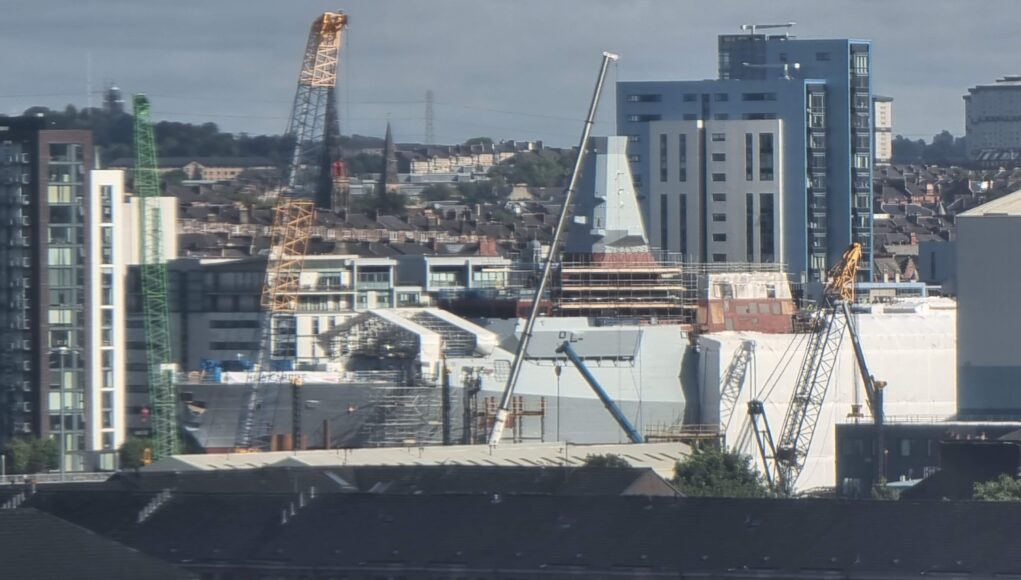


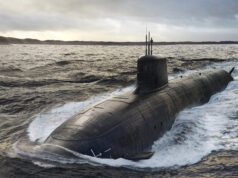
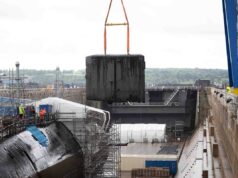
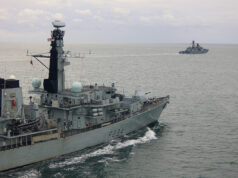
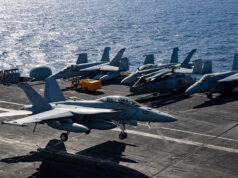

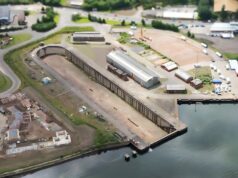
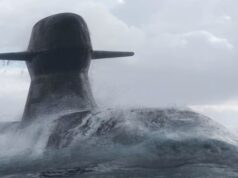


Would this composite also be less visible to radar ?
That is the general idea
Yes …but…Externally transparent but internally its full of equipment with nice sharp profiles and edges to reflect baqck radar.
In addition anything internal will need some serious TEMPEST protection to stop stray electronic emissions getting out with no steel mast to stop it.
Such things in that area are SCOTT, ESM and Radar.
Hunt class MCMVs had issues years ago when they got close to SPY1 Radars on USN Ships. The radar energy could go through the hull (GRP) and shut down the propulsion system control electronics. The ship would be dead in the water until the Tico or AB sailed away allowing the machinery control system to start again.
Thank you for the comprehensive reply, I know very little about such things so I have some stuff to look up later 🙂
Would wrapping the inner parts in a faraday cage solve some of this ? or am I way off in my understanding ?
The radar return beam is guided down through the mast in a Wave guide conduit which is a precise milled metal trunking so the beam is protected from any outside interference Mark
Not so much nowadays as the Tx/Rx are now in the radar head (AESA). Signals are fed up and down digitally to signal processors below decks.
God I’m an analogue kind of guy GB
Can confirm that Gunbuster , whilst out in the Gulf on a Hunt the Chiddingfold whenever the yanks flashed up their Aegius radar it would crash our Generators
I was working EM2 CCWEA and the stories they had!!!
Yeah if we were closed up at the time the only things that we could operate were the 2 Gambos and GpmGs millions of pounds worth of equipment was knocked off line by the power emissions generated by the Yanks thank god no one had a Pacemaker fitted joke
So would our D45’s have the same issue with radar energy?
Reduces fuel consumption ? put some solar panels on it sorry but did the MOD put a tender out too UK companies first rather than BAE awarding the tender
Probably not, it’s typically up to the prime contractor who they tender their subcontracts too. It would be kind of difficult a prime contractor to offer HMG a price if one of the conditions is that HMG gets to pick the subcontractors.
Also, I might be wrong about this, but I’m pretty sure that radar masts is a very specialised field and there are no UK based manufacturers, could be wrong tho.
You can have novated subcontractors in most forms of contract.
For agreed bits that can be the way fields.
Meta centric weight is the issue here.
The weight at the top of the mast is key – but also its stiffness and reactions – no point in having something perfectly aligned if it ‘whips’ in a high sea state.
Novated? Is that an autocorrect or a term I’ve not heard of?
Novated: “Replace with a new contract”
Clients can also novate a subcontractor.
Although this does mean that the client is the one approving the competence of the subcontractor and any ensuing foul ups are therefore on the client’s $.
Most if the time it isn’t a great, particularly in domestic building works, idea as the sub contractor tends to pay zero attention to the main contractor.
Yes at massively increased price, no country on earth can keep 100% of their warships supply chain domestic. Massive cost increases just so we can make 8 Masts in the UK instead of Norway seems pointless.
Exactly
Sensible compromises to get things done affordably.
If we had to we could make them in the UK. But there is no point.
Also the Nordics are reliable partners and collaborating with them is a good idea.
Thanks Dern , I believe that although the mast is of Norwegian construction ,t the Radar wave guide trunking is British build
Cheers Dern , I take it that although the mast is being outsourced to a Norwegian company the internal fit will be British companies ie Radar guides EW equipment etc
Your corect and i dont think a company could exist on 8 mast Umoe Mandal are a specialist in this field in composite
The spelling on here is getting worse buck up boys!
20% less weight when composite instead of steel. Plus the for structure high up you would have to have extra beam to maintain stability, so weight savings there too
Also depends whats goining up the mast.
You couldn’t put a 9 Tonne Sampson radar up there but for T26 a lightweight radar is OK.
It will cut down on a shed load of maintenance as well. Mast preservation is a major effort requiring staging and mechanical treatment before painting. Composites wont require this. Good for the navy…Bad for me in Ship Repair!!
Horses for courses.
I’d say this was the optimal choice for this kind of ship.
Gunbuster,the very man. How exactly is the composit mast fitted to the upper deck and do they fall away at a certain incline??👍
Ones I have seen are bolted. They will not fall off
👌👍
There are some contract parallels with the building Industry(SA) here. Generally the main contractor will submit a tender selecting his own sub-contractors although client is entitled to appoint nominated sub-contractors up front. There are several reasons for this among them and probably applicable in the case of Umoe Mandal here, is that the item or service is highly specialised or the subbie is already on site elsewhere and it would make sense for him to perform this particular service. An example would be if an electrician is already installing on site or an aircon system is being extended. The professional Quantity Surveyor would adjudicate the fairness or otherwise of the price.
A general question-is the slow rate of build of the Frigates a function of deliberate budget restraints( i.e. we only have X Pounds to spend each year) or just because they are enormously complicated with difficult sequencing necessary? The start to commissiong times these days some times seem crazy-a decade plus!!
Best sonar dome manufacturer in Europe is a UK company who export all over.
Its Swings and roundabouts.
All countries have their specialist suppliers. Norway happen to be good at V Large composite structures such as this mast.
Groovy 👌
Wouldn’t this have been Aluminium rather than steel in earlier frigates? -To keep wieght down with higher parts of the ship. Aluminium is even lighter I think, closer to 50% the weight of steel..
Frank ,the old type 21s superstructure was of an Aluminium build for weight ratio the lighter build helped with stability and unfortunately had a lower melt temperature as we saw in San Carlos water when the 21s were hit great idea by the planners for the build and cost but not a material which can withstand a fire like steel can
Yep,as were nylon/polyester overalls 🤬💩☠️
Yeah that was another cost cutting blunder and then in 83 we reverted too a cotton based 8s and overalls
It was found when the ships were back, that, after testing the mattress’ when burnt out the glasses released included cyanide! All of those mangy thing went to the prisons
Yep correct. Amongst a myriad of other high class fuck ups. Shortly after I was sent by my boss on a, what at the time, a new health and safety course, at Lee_on_solent. Well, highly revealing and absorbing. I remember thinking, how do we implement this into the RN.!! 👏 But then, quite rightly, we now have female sailors. Very changing times 🚺👏👍👌.
Looks to me as if Cardiff (she is not HMS yet) will be ready to go to Scotstoun next year. As Glasgow will still be fitting out how many T26s can they have in Scotstoun at any one time?
With the condition and potential cost of keeping the T23 fleet operational would it be possible to ramp up the build speed of the T26s?
She almost looks ready to go now, wondering if she will get an early launching, November?
Scotstoun can certainly take 2 at a time
Fleet has requested an increase in build speed and also quicker dockyard refit periods to get units in and out far more quickly.
Is this not a huge fire risk?
There are resins that are either self extinguishing or don’t really burn.
There will also be an intumescent layer applied so that the composite is thermally insulated from any fire heat source.
They said the same about aluminium structures and building cladding, until they caught fire.
RN ships are tested very thoroughly wrt fire.
I used, for a very short time, to test resins for Loyds certification many moons ago.
Cladding issues were due to no real valid testing or certification. And then ignoring any sensible installation guidelines.
A lot of people had been warning of the cladding issue but were silenced because the industry waved around test certificates and legal threats.
Composites and things like GRP in ships are designed to char and self-extinguish in a fire. They also don’t transmit heat like steel and ally so boundary cooling in a fire is less of an issue.
Obviously if the fire is large enough and hot enough its going to be an issue but if it is? Then you have other stuff to worry about!